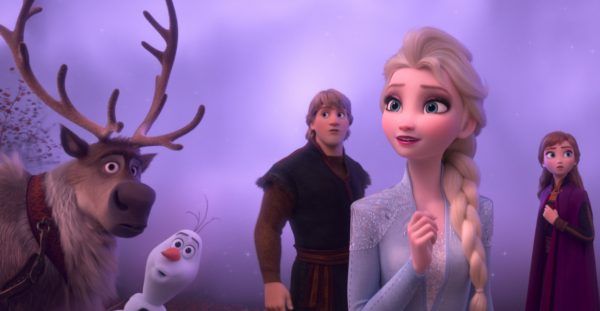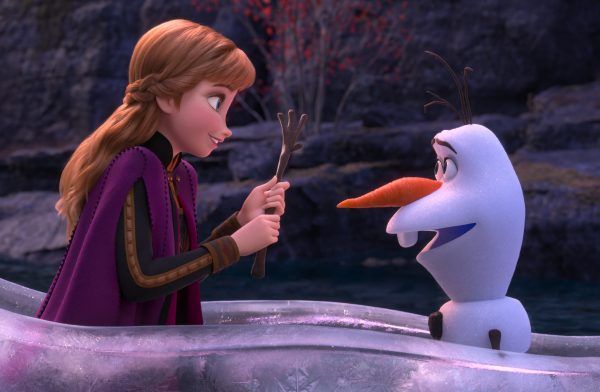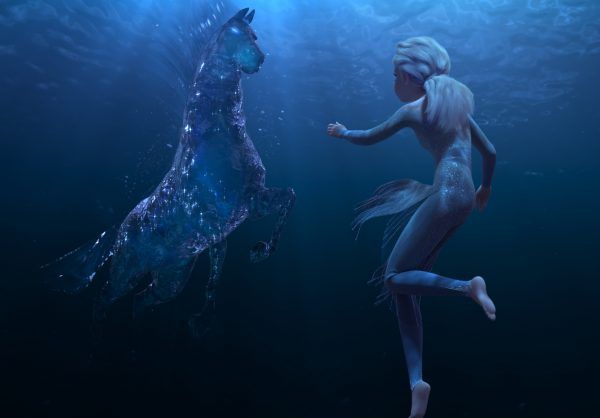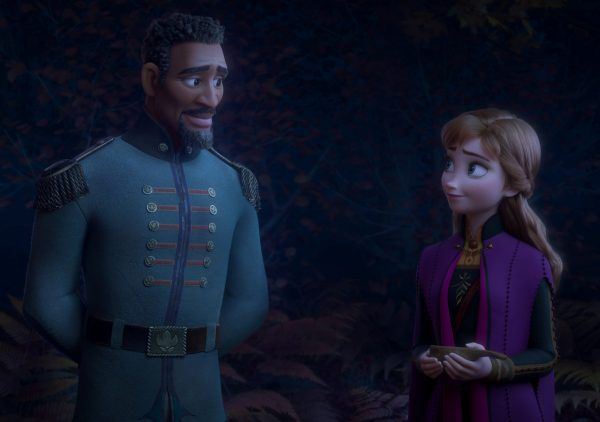Even though the filmmakers were still hard at work finishing the highly anticipated Frozen II in time for its November 22nd release date, they invited members of the media out to Walt Disney Animation Studios on September 6th to preview various parts of the film, as well as some of the new original songs. Directed by Jennifer Lee (who’s also the Chief Creative Officer at WDAS) and Chris Buck (Tarzan) and produced by Peter Del Vecho (who’s also Senior Vice President of Production, overseeing the production for all of the feature films at WDAS), the sequel to the highest grossing animated film of all time in worldwide box office will see Elsa (voiced by Idina Menzel), Anna (voiced by Kristen Bell), Kristoff (voiced by Jonathan Groff), Olaf (voiced by Josh Gad) and Sven set out on a dangerous journey to discover the answers to why Elsa was born with magical powers, and they’ll learn whether those powers are enough to ensure their survival.
At an early preview day held at Walt Disney Animation Studios, Collider got the opportunity to sit down and chat with Marc Smith (Director of Story) and Normand Lemay (Head of Story) about the long journey of development for the sequel, what they’re most excited about audiences getting to see with the film, wanting to do something different this time around, the biggest challenge they had to overcome with Frozen II, making sure the new characters always came from something to do with Anna and Elsa, earning the ending, and their journeys to get to Disney Animation.
Collider: Obviously, you’ve been working on this for awhile now. What are you most excited about, with this finally coming out and knowing that people will get to see it?
NORMAND LEMAY: We work in a bubble. We know what the movie is, and we can’t wait to show it to the world. We also can’t wait to see the final product. Both me and Marc have, on purpose, stopped watching all of the final renditions of all of the sequences, in their final product. We wanna be surprised, and go to the wrap party and see the movie, almost for the first time We know what it is, but we don’t know, at the same time. I find that very exciting, waiting to see it, as an audience would say.
MARC SMITH: I’m excited that that we took the characters in a much deeper place than the first film, which is what you would expect. We wouldn’t want it to just be like, “Oh, it’s the same old characters, and now something else comes into town.” It feels like this one really pushes and takes it into some really difficult places. Thematically, there are some really interesting and important themes that I’m really excited to see go out into the world.
It seems like it could have been really easy to just to do a similar kind of film with a reprise of the songs, that all feels very familiar, because you know it worked the first time. Is it a little scary to do something so different?
SMITH: Yeah. Really early on, (co-directors) Chris [Buck] and Jen [Lee] knew they really didn’t want to do that. They were very much like, “Okay, if we’re gonna do this, it needs to feel like removed from Frozen I. It should feel like a piece, a story, and a life that’s lived between these characters.” You don’t wanna forget all of the history that they have, but you also wanna take them places that they haven’t been before. That was actually the really exciting part about coming onto this. Once that started to like bubble up as possible, we realized that there were some interesting things that haven’t been explored with these characters, and there are emotional places that we can still go with them. I was like, “I don’t know how we’re gonna do it, and I don’t know what’s gonna happen, but it’s worthy, so let’s just keep going with it.” That was the fun of it, and hopefully that’s what people will respond to.
What was the biggest challenge that each of you had to overcome with making this?
SMITH: For me, that was it. It was just about, emotionally, are we gonna be able to go any further? That was the big question. Emotionally, it was resolved in the first movie. Everything felt like, “Okay, that’s it. The story is over.” So, we had to be able to find something that feels believable.
LEMAY: And could reignite that fire.
SMITH: Yeah, and that was the daunting part. But that was early on. Once we were like, “Okay, we can do this,” then it was just hard work. It’s worthwhile, but it just takes so much work and time and lack of sleep. It’s enough to know that you’re going after something that you feel can be rich enough, artistically. It’s a lot of work, but that’s fine. We’ll do it and, hopefully, it will be reacted to, the same way.
LEMAY: It’s always about trying to emotionally connect with those characters and take them to a place that feels real, and where these characters can still be vulnerable and exciting and curious about something new, or to discover something new or deeper. We keep saying the word deeper, but it’s true. What’s different for these characters is that, in the first movie, they were all disconnected, and the meat of the movie was to try to get the characters together. That was mostly with Anna and Elsa, but we now have a family of characters, and it seems that they have much more to lose, now that they’ve gained that. They’ve been living this stable life for three years, but they discover, underneath the surface, that there are still some issues, especially between Anna and Elsa, that we can still explore.
Is it fun to see how the familiar characters interact with the new characters that have been added to the story?
SMITH: Yeah. The new characters always come from something to do with Anna and Elsa, and some way to challenge them, or get something out of them, or shine a new light on their relationship somehow. In the first movie, Elsa was the lone magical being, for the most part. She has this power, in a world of people without powers. In this movie, we open it up. There are these other elements that come into play, in Act 2, and the whole world opens up, at that point. Story wise, it just felt like it was a more magical, bigger world than we had in the first one, and that gave us a lot of interesting story situations and themes to start playing with and to start putting them into.
LEMAY: In the beginning, interacting with something that’s magical outside of her ignites that curiosity that she’s been having since she was a little girl. This idea of, am I alone? Will I ever find something outside of me that feels more like me? It feels like it’s the beginning of that curiosity that will push her to become more and to discover herself even more.
It sounds like, with both the first movie and with this one, the end point was pretty well set, and that it was more about figuring out how to get there. Was it more the journey rather than the ending that evolved a lot, throughout the process?
SMITH: It did, yeah. We tried a lot of things. The resolution came about pretty early, and then it was a matter of earning it, and that’s really hard. You’ve gotta do it in a satisfying way that’s compelling and feels inevitable, at the end. There was a lot of work put into that.
When was the moment where you felt like you’d really earned the ending to the story you wanted to tell?
SMITH: For me, it usually happens in stages. We can have a scene in a movie and watch it and it can work, but in the next screening, it doesn’t work. And then, there’s a screening, at some point, where it just all comes together and you’re like, “Okay, I’m really feeling what that character is feeling. It got me, emotionally.” And that’s good. Once those start adding up and start connecting to one another, and you’re constantly feeling something while watching the film, then it feels like it’s all adding up in a way that feels bigger than its parts. So, the answer is that it happens in stages, and then the movie is over.
LEMAY: It’s so elusive, but it’s just about connecting and having people in the room truly reacting to something that they’re experiencing and feeling. I can’t wait to get there, and we have to figure out, how do we set it up, earlier on? What do we put in the sandwich, after and behind it, to support all of that? Do we create new scenes that will make us feel the same way? Does it all help the bigger picture of where we’re going? That’s how we get to it. It’s slippery and we keep iterating until it feels like we’ve got something.
SMITH: It’s probably cliche, but it’s true that there is a point, in all of this movies, where they do start to tell you what to do and what not to do, character wise and movie wise. When you’re watching a screening and it just stops, then you’re like, “Okay, even though that’s a great sequence, it just stopped and we lost it.” And then, we have to get rid of that.
How did you guys end up in animation at Disney? Was Disney always the goal for you?
SMITH: It’s the only job I’ve ever had, so there’s not much path, before I came to Disney. I cleaned pools, and then I came to Disney. I ended up at Cal Arts, and quickly after that, Disney pulled me in, two years later. I would just draw animated movies, all of the time, but I didn’t know that was where I was gonna end up. It just happened, in a weird way. That was it, for me.
LEMAY: For me, it took a bit more time. My goal was that I’ve always wanted to work at Disney and try to make my way there. So, as much as I could, I earned the experience and the skills to be accepted there, and then have tried to stay.
Frozen II opens in theaters on November 22nd.





